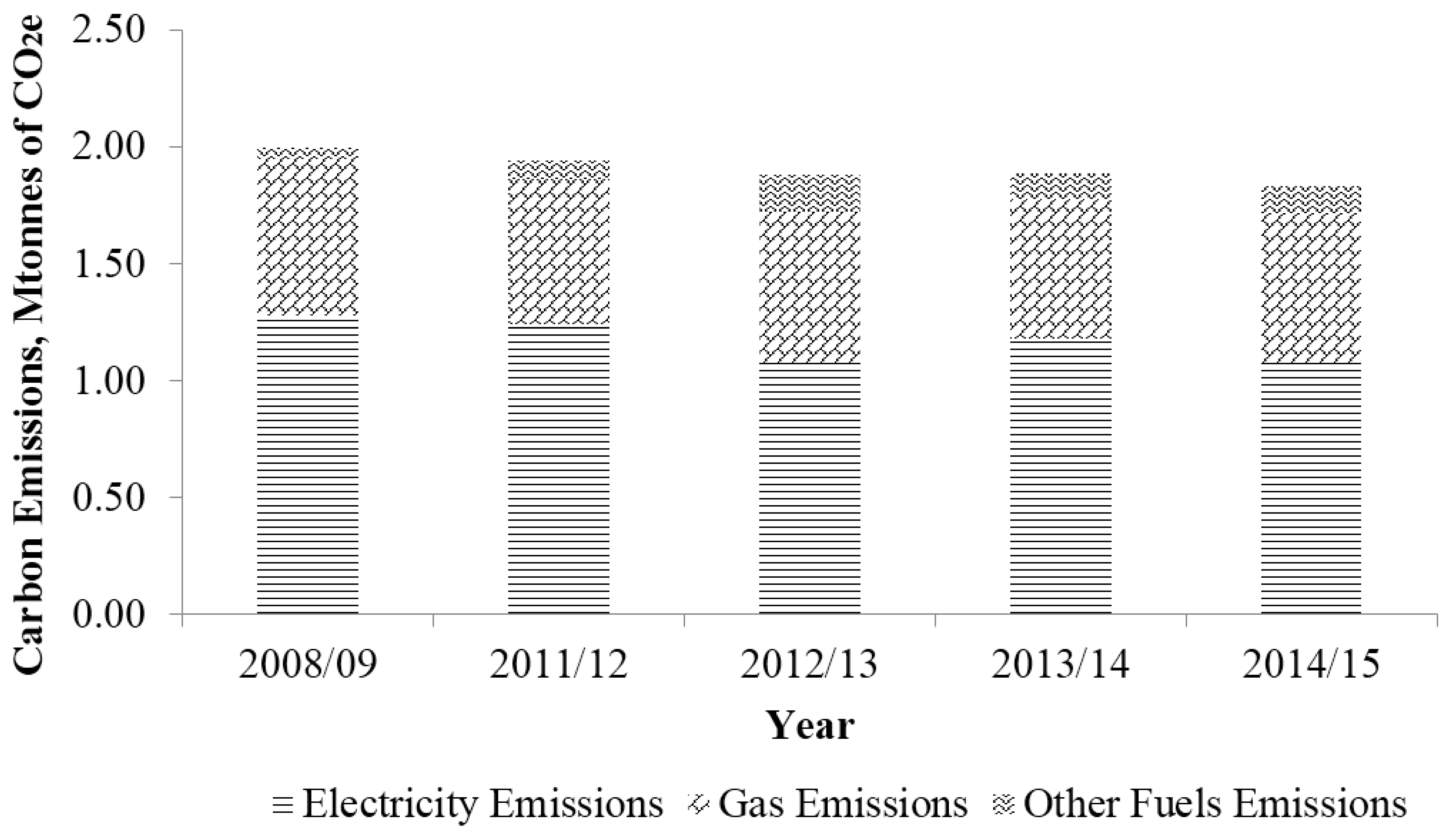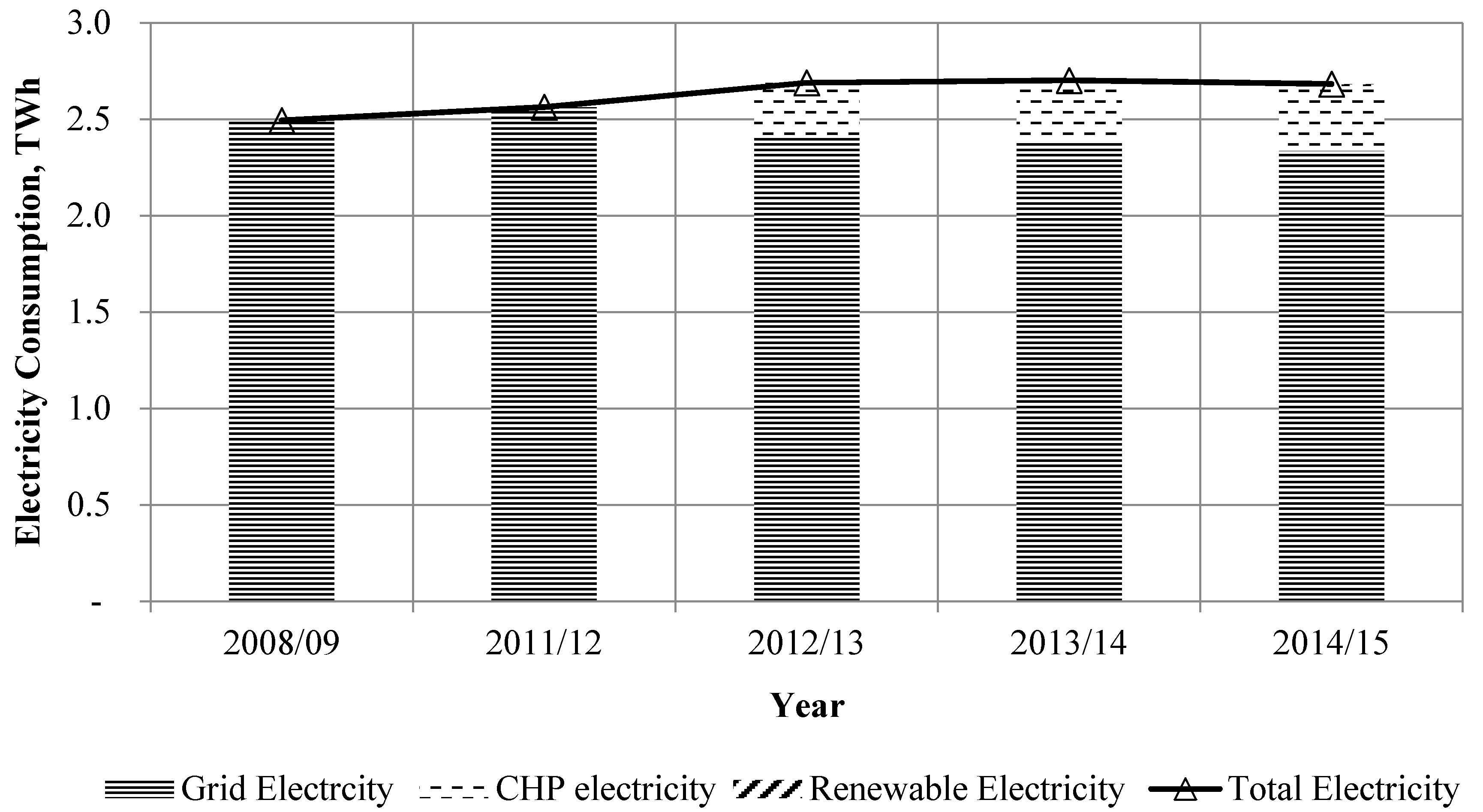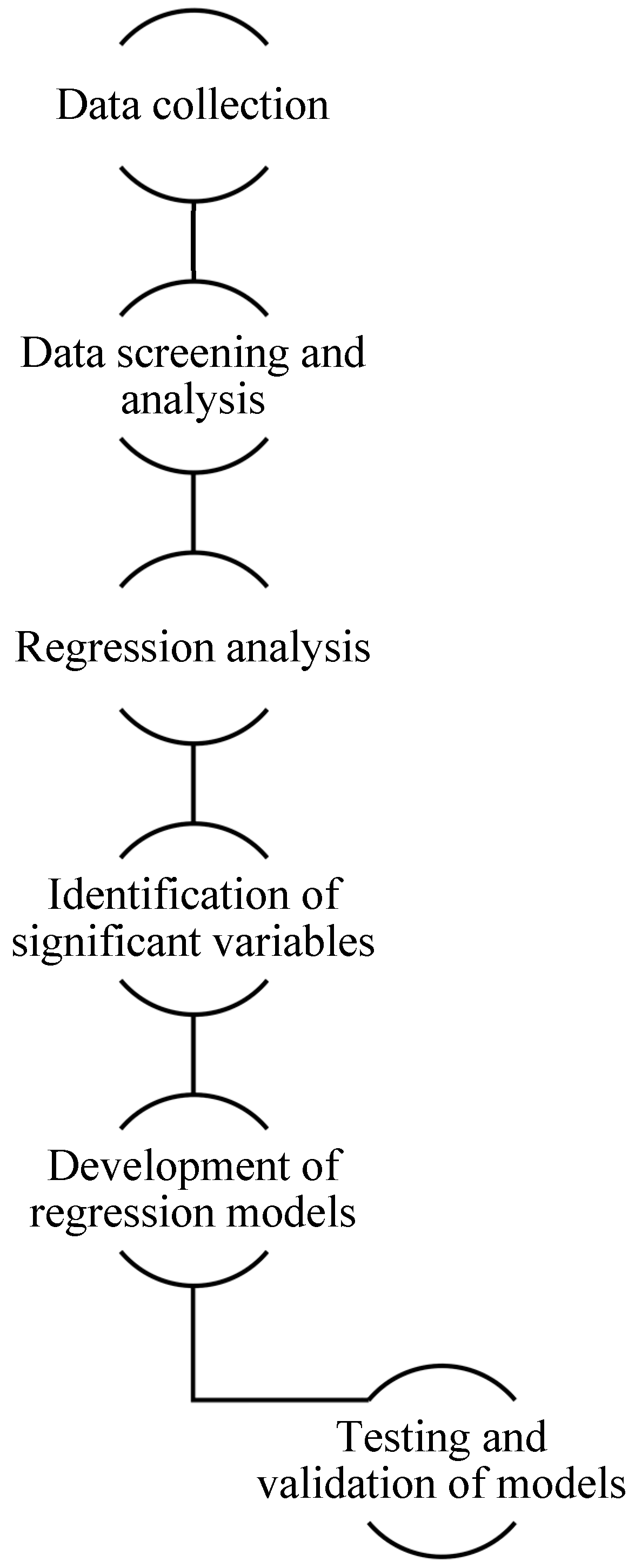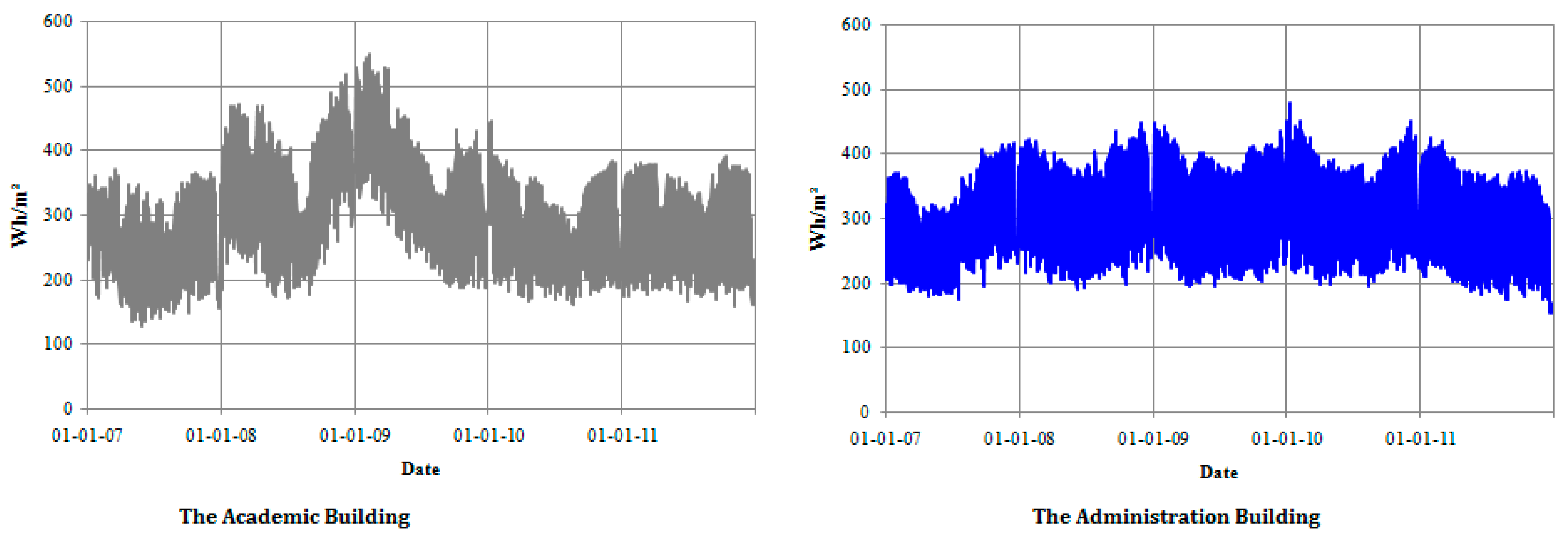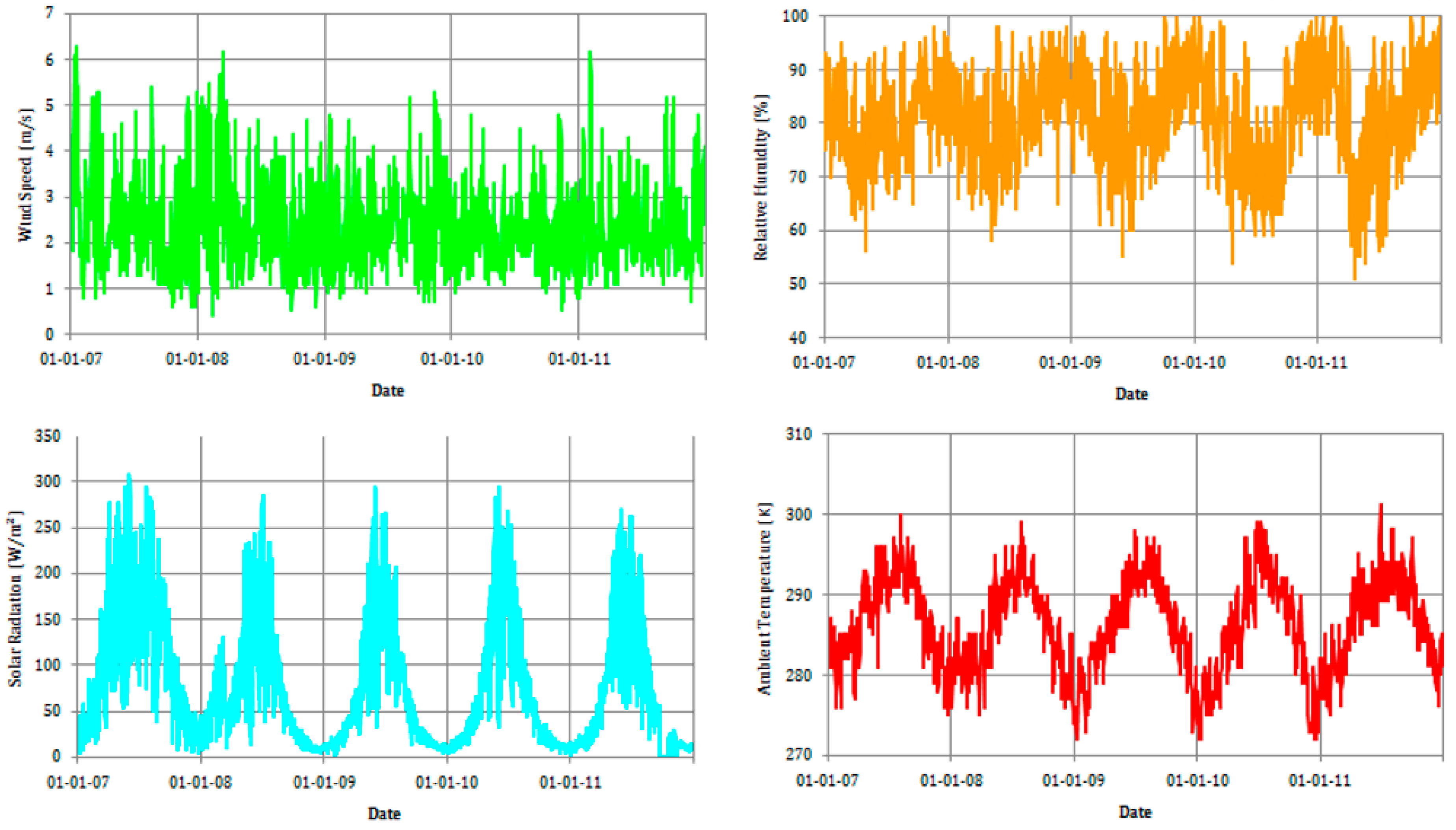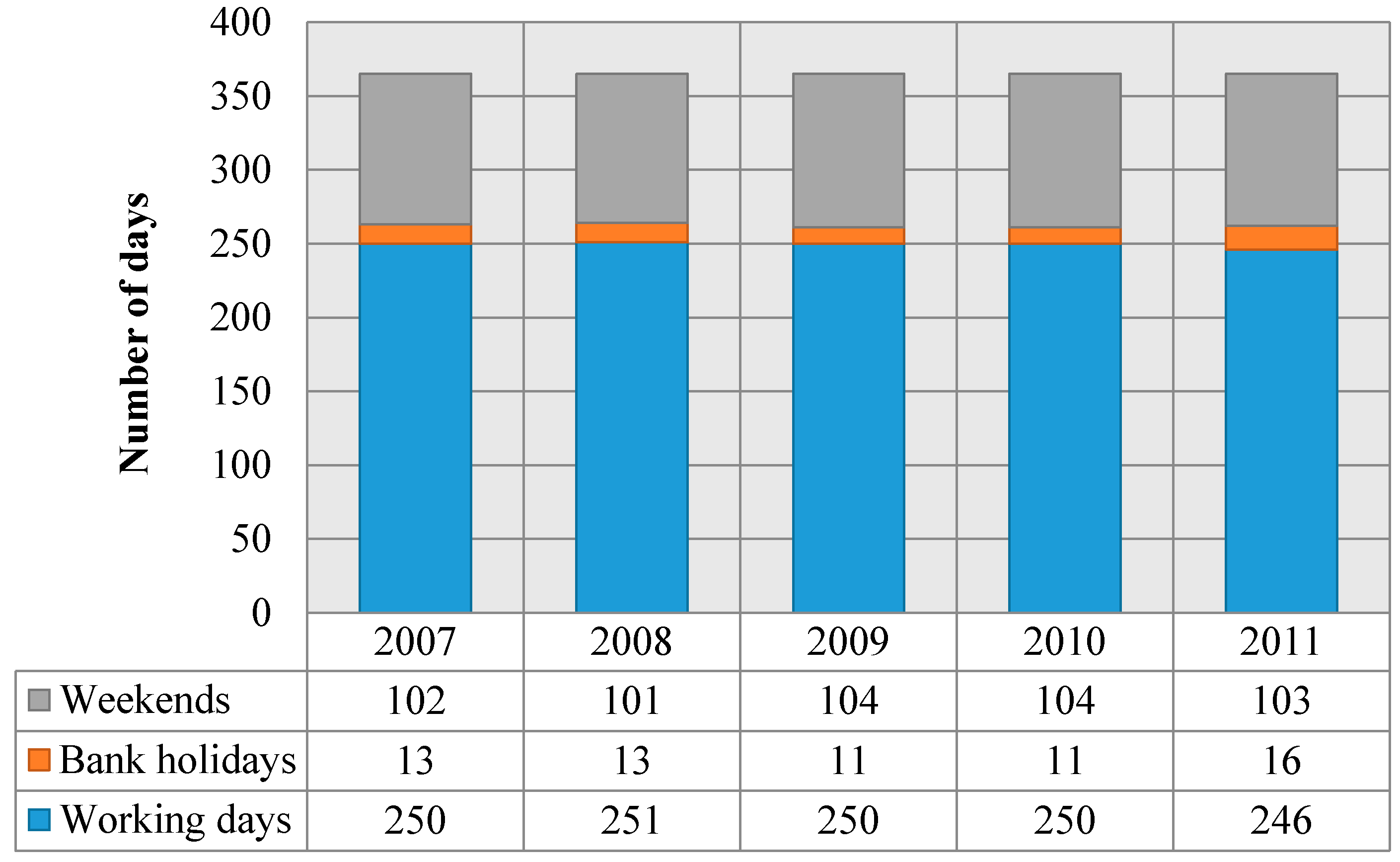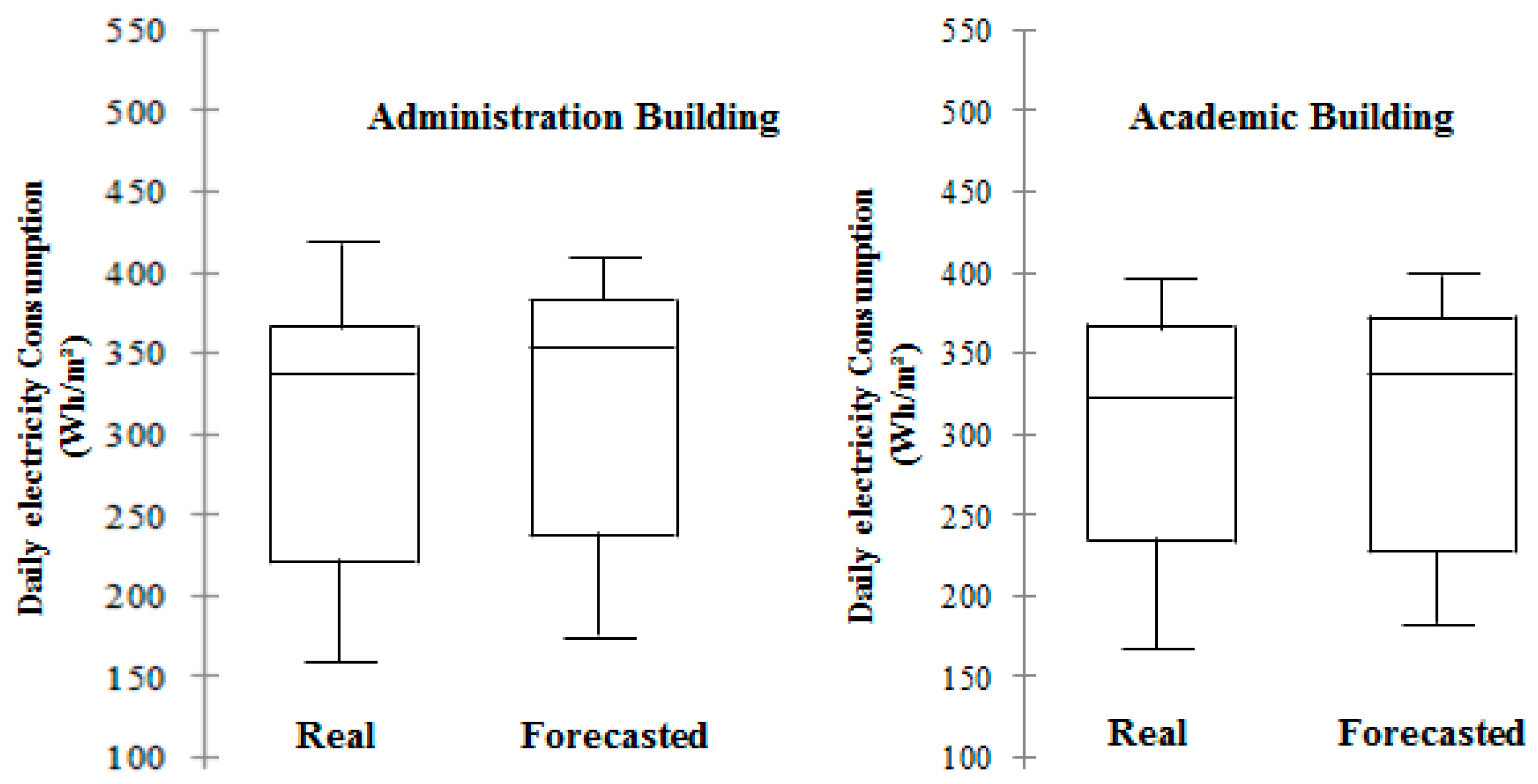1. Introduction
In the U.K., buildings are the major energy consuming sector, with a share of 40% [
1]. The electricity consumption in Higher Education (HE) buildings is the major factor in the sector’s carbon emissions [
2]. Energy management systems have gained rapid recognition in the U.K. HE sector after the Higher Education Funding Council of England (HEFCE) imposed a 43% reduction in carbon emissions by 2020 against the baseline year 2005 for its all member universities [
3]. All member universities in England now have a dedicated energy management team consistently working to achieve this goal. Variation in the sector’s CO
2 emissions for the period 2008/09 to 2014/2015 has been shown in
Figure 1. It depicts that electricity consumption emerges as the major contributor with a share of 63%, next to which is natural gas with a share of 33.3% [
1,
4,
5]. It can also be observed that annual reduction in sector’s emission is slow at a rate of 2.17% per year. During these five years (i.e., 2008/09 to 2014/15), the sector has been able to reduce its total carbon emissions only by 8%.
Table 1 presents variation in number of students, electricity and gas consumption, emissions and Gross Internal Area (GIA) for the English HE sector. Variation in the sector’s CO
2 emissions with respect to GIA (m
2) and number of students was reported in [
4]. It was observed that sector’s emissions based on GIA decreased by 15.83% at an annual rate of 4.2% during 2008/09 to 2014/15; a promising result compared to total absolute CO
2 emissions. Average CO
2 emissions per square meter area of a typical university campus in England were reported to be 90 kg/m
2 for this period. The average CO
2 emissions per student during the same period were 1210 kg/student. In this context, the CO
2 emissions decreased by 7.8% during 2008/09 to 2014/15 with an annual decreasing rate of 1.86%.
Figure 2 presents variation in electricity consumption of the English HE sector for the period 2008/09 to 2014/15. It is evident from
Figure 2 that sector’s total electricity consumption has been increasing since 2008/09 to 2014/15 at average annual rate of 1.87%. However, it could also be observed that due to energy efficiency initiatives of universities and injection of electricity from on-site Combined Heat and Power (CHP) plants as well as renewable sources (solar and wind) grid electricity consumption has decreased annually at 1.56%, totaling 6.27% lower in 2014/15 compared to 2008/09 levels. As grid electricity has higher carbon factor than the CHP or renewable electricity, therefore the decreased grid share corresponds to a higher decrease in carbon emissions.
Annual variation of sector’s gas consumption is presented in
Figure 3. Gas consumption was observed 14.5% higher in 2014/15 compared to 2008/09. This increase is associated with installations of CHP plants in universities for onsite energy generation. Towards the end of 2011–2012, 59 of the 161 U.K. universities had installed CHP on their campuses [
3].
The overall effect of electricity and gas consumption could be judged by looking at the sector’s CO
2 emission levels, which clearly shows that emissions are decreasing at a slower annual rate. This declining trend in carbon emissions certainly reflects the overall efforts made by the universities aiming to achieve their carbon-emissions reduction targets. However, despite such efforts and a number of ambitious initiatives, the English universities are far behind achieving their 2020 emissions reduction targets [
6].
Energy consumption in university buildings is mainly driven by various factors such as; building type, building age, occupancy, operating hours, type of equipment installed and weather conditions. Nearly 68% space of a typical university campus in England is occupied by two major building categories, i.e., academic (42%) and administrative (26%) buildings [
6]. In 2014/15, non-residential buildings of English universities consumed about 80% of total energy consumption where as 20% electricity consumption occurred in the sector’s residential buildings [
4].
The aforementioned information clearly shows that electricity and gas consumption are the two major carbon emitting sources of the HE sector of England, with shares of 63% and 33%, respectively [
4]. The sector’s slow declining trend of carbon emissions clearly indicates that the universities need to explore additional energy saving opportunities along with improving the energy management systems of the universities.
Monitoring and analyzing buildings energy consumption patterns is one of the major components of an effective energy management system which helps in understanding the building’s operational behavior under different conditions. It also helps in identifying undesired wastage of energy under specific conditions. If the energy consumption data are collected and maintained properly, their relation with different variables such as surrounding temperature, humidity, occupancy etc. could be investigated and future energy predictions could be made by taking these factors into account. Another key benefit is that predicted energy consumption data could be used to predict reliable energy budgets for future. Energy management teams of universities are responsible for monitoring, analyzing and maintaining energy consumption data of their buildings. They are responsible for preparing reliable energy consumption forecasts in order to prepare their energy budget forecasts for the coming years as well as identifying opportunities of energy conservation.
Reliable energy consumption forecasting plays a critical role in successful implementation of energy management systems. Many organizations have failed in managing energy consumption and budgeting because of lack of forecasting and use of less efficient forecasting techniques for planning [
7,
8]. Forecasting helps in evaluating the current and future economic conditions to steer the organization’s policies and decision making. It is a technique that predicts the future information based on historical and current information. A reliable forecasting can help universities financial and energy management teams to set up their priorities and strategic goals and it can act as an integral part of the annual budgeting process [
9].
Different forecasting techniques such as Multiple Regression (MR), Artificial Neural Networks (ANN), and Genetic Algorithms (GA) have been widely used by researchers for energy consumption forecasting for different types of buildings in different regions [
10]. Among these, MR is a simple, reliable and a quick technique [
11,
12,
13,
14]. A number of researchers [
11,
12,
15,
16,
17,
18,
19,
20,
21,
22,
23,
24] have used the MR method in their studies, but all such MR models forecast energy consumption of a single building or a region and require a lot of input data. Energy managers and their teams have always busy schedule and they would prefer a reliable and quick single model for different building categories instead of different forecasting models [
24].
This research aims to facilitate the energy management teams of English universities by providing a simple, easy to use, quick and robust energy consumption forecasting model using MR technique in the form of a simple mathematical equation. Using this single equation, energy managers will be able to predict daily, monthly and yearly energy consumption of two different types of buildings, i.e., administrative and academic. For this purpose, two campus buildings (one academic and second administrative type) located in Southwark campus of London South Bank University (LSBU) are selected and their historical electricity consumption data are used in the development of forecasting model. Daily electricity consumption data of these two buildings for a long period (i.e., 2007–2010) was available but daily gas consumption data was not available. Therefore, due to unavailability of daily gas consumption data, this research only focuses on electricity consumption forecasting model.
London South Bank University (LSBU) is a public university located in Central London. It has 17,735 students and 1700 staff and is based in the London Borough of Southwark. LSBU is located at 51.4982° N, 0.1021° W. The University has 31 buildings (GIA: 148,771 m2) in total, of which 19 are non-residential buildings occupying a Gross Internal Area (GIA) of 114,065 m2 while remaining 12 are residential buildings occupying GIA of 37,706 m2. The energy management team is responsible for energy and environment related matters such as:
- (a)
Monitoring, analyzing and maintaining record of energy consumption;
- (b)
Identifying energy reduction opportunities and setting up targets;
- (c)
Compliance of national legislation/schemes such as Carbon Reduction Scheme (CRC);
- (d)
Preparing forecasts for energy budgets based on historical energy consumption data;
- (e)
Display Energy Certificates (DECs).
LSBU has to meet a target of 43% reduction in its CO
2 emissions by 2020 against the base year 2005/06. In 2005/06, total emissions of LSBU were 12,165 tCO
2 which means that it has to reduce its emissions to a level of 7907 tCO
2 by 2020.
Figure 4 shows variation in the CO
2 emissions of LSBU for years 2008/09 to 2014/15. It is evident that due to University’s imperative energy reduction initiatives, the University has been able to reduce its CO
2 emissions by 32% in 2014/15 compared to 2005/06. Major drop in CO
2 emissions was observed between 2005/06 and 2008/09 where emissions dropped by 24%. However, from 2008/09 to 2014/15, LSBU was able to reduce its CO
2 emissions just by 8%. Major sources of these CO
2 emissions in LSBU are electricity (74%) and natural gas (26%).
The following researchers have applied MR method in their energy forecasting studies:
Fumo and Biswas [
10] employed the MR method using long term hourly and daily energy consumption data of a domestic building. They used two explanatory variables, i.e., global irradiance and the outdoor temperature; the inclusion of former improved the coefficient of determination, R
2, however, resulted in an increased RMSE.
Catlina et al. [
12] used the MR method to predict heating energy consumption of buildings based on three factors namely; the building global heat loss coefficient, the south equivalent surface and the difference between the indoor set point temperature and the sol-air temperature (sol-air temperature (Tsol-air) is a variable used to calculate heating or cooling load of a building and determines the total heat gain through exterior surfaces.), that influence a building heat consumption. A detailed error analysis showed that their model presents a very good accuracy with R
2 = 0.987.
Amiri et al. [
22] developed two MR models for the prediction of annual cooling and heating energy consumptions of the buildings. Among the 17 tested explanatory variables 13 were found significant, of which occupancy schedule and exterior wall construction have major influence on cooling and heating loads. Both MR models were found good with R
2 ranging from 0.95 to 0.98. Their study concluded that MR is an accurate, simple and fast way to obtain energy performance of administrative buildings.
Mastrucci et al. [
23] employed the MR method to forecast electricity and natural gas consumption of domestic buildings in The Netherlands. In this study, the influence of type of dwelling, building age, floor area, and occupancy on the buildings natural gas and electricity consumption is analyzed. To assess the predictive power of the model, they used R
2 and Mean Square Error (MSE). R
2 values for natural gas and electricity models were found to be 0.718 and 0.817, respectively.
Bruan et al. [
11] applied an MR method to investigate effect of outdoor temperature and humidity on the buildings electricity and gas consumption. It was found that temperature has the highest influence on the buildings energy consumption with R
2 = 0.92 for electricity consumption and R
2 = 0.85 for gas consumption. The predictive power of MR model has been tested by analyzing the Normalized Mean Biased Error (NMBE) and Coefficient of CVRMSE. It was found that NMBE is −2.6% whereas CVRMSE was found to be just below 3.8%.
Capozzoli et al. [
25] analyzed annual heating energy consumptions of eighty school buildings in the north of Italy and developed an MR model to estimate energy consumption of these schools. They used nine different influencing variables and tested the predictive power of their model based on Mean Absolute Percentage Error (MAPE). The results of this study suggested that the MR model is a decent model with R
2 = 0.85 and MAPE of 15%.
In the light of the above discussion, it is clearly seen that most of the MR models developed for energy forecasting purposes are for the single building category, whereas the energy managers of a typical university campus are responsible for different building categories. This highlights the significance of a quick and robust forecasting model for different building categories. This study, for the first time proposes a unique MR model for multiple building categories based on five years real historical data. This will not only provide a quick forecasting tool but also a reliable mean of forecasting energy consumption for multiple building categories. Energy managers will be able to prepare reliable energy budgets for their procurement of their annual energy usage in order to assist the higher management in setting up their financial priorities. Rest of the paper is organized as follows:
Section 2 describes the methodology of this work whereas in
Section 3 results have been discussed. Conclusions are drawn in
Section 4.
3. Results and Analysis
In this study, multiple regression method has been applied on the data for the period from 1 January 2007 to 31 December 2010 for identification of significant and insignificant variables.
Table 5 gives the preliminary MR results and a collinearity analysis among various variables. The MR model suggests that all the variables except wind velocity have
p-values less than 0.05 demonstrating that all the variables except wind velocity are significant and cannot be ignored [
39]. Wind velocity having
p-value higher than 0.05 indicates its weaker relationship with the buildings electricity consumption. The overall R
2 value for all the variables is 0.73 which shows high relevance between the explanatory and the dependent variables. The collinearity analysis in
Table 5 gives a picture of relevancy of variables among themselves. A high collinearity between any two variables suggests that only one of them can be used as they behave in a similar way.
Table 5 demonstrates high collinearity (R = 0.69) between surrounding temperature and global irradiance. A similar trend is seen between global irradiance and relative humidity with a collinearity value −0.61 while surrounding temperature and relative humidity have relatively weak (−0.42) collinearity value. Since the surrounding temperature has a high collinearity with global irradiance and same is true for global irradiance and humidity. Therefore, the latter two variables (global irradiance and humidity) can be dropped and former (temperature) should be considered. Rest of the variables have poor collinearity with each other so these can also be included. Wind velocity being insignificant could be eliminated from further analysis. A final modified MR model is presented in
Table 6. The model’s equation for predicting daily electricity usage (Wh/m
2) of the administrative or academic building is given by Equation (4):
which implies that
Ed = f (
x1,
x5,
x6), where
x1 = Daily mean normalized surrounding temperature;
x5 = Normalized Weekday Index;
x6 = Normalized Building type.
The MR model equation clearly demonstrates that there is a negative linear relationship among daily electricity consumption and surrounding temperature. This is true as high temperature will reduce heating demand of the buildings which means heating equipment and its accessories such as pumps, air handling units (AHUs) etc. will not run thus resulting in decrease in daily electricity consumption. It also suggests that daily electricity consumption on a working day will exceed by 145.3 Wh/m2 than that on a non-working day.
The proposed model has R2 value of 0.72 (the preliminary model had 0.73), demonstrating that the predictive power of model has not changed much after dropping three variables. Therefore, from the R2 analysis, it is obvious that the proposed model is an effective predictive model. By putting the values of surrounding temperature, building type and weekday index, one could easily forecast daily electricity usage of their buildings and could prepare a reliable energy budget forecast. This model equation has been tested to predict electricity consumption of the same two buildings for the period 1 January 2011 to 31 December 2011. Later, this forecasted electricity consumption has been compared with real daily electricity consumption of the two buildings for the same period and it is discussed in next section.
